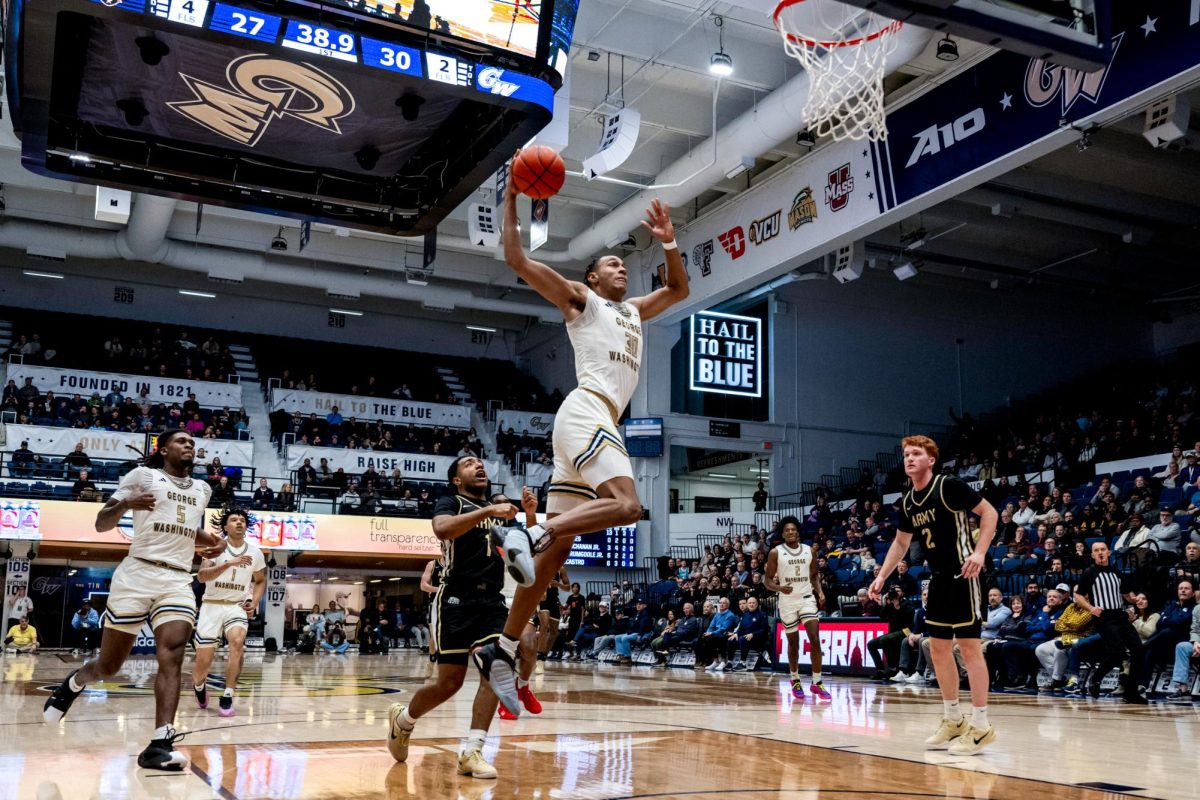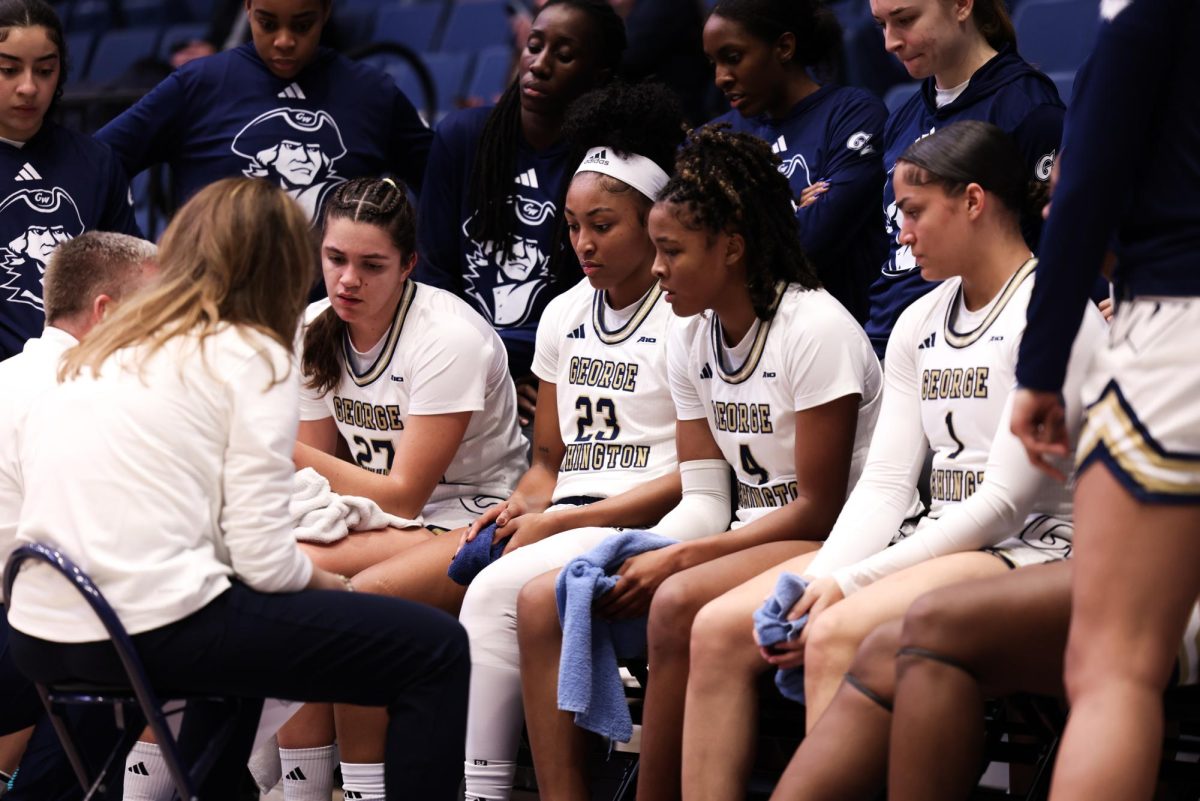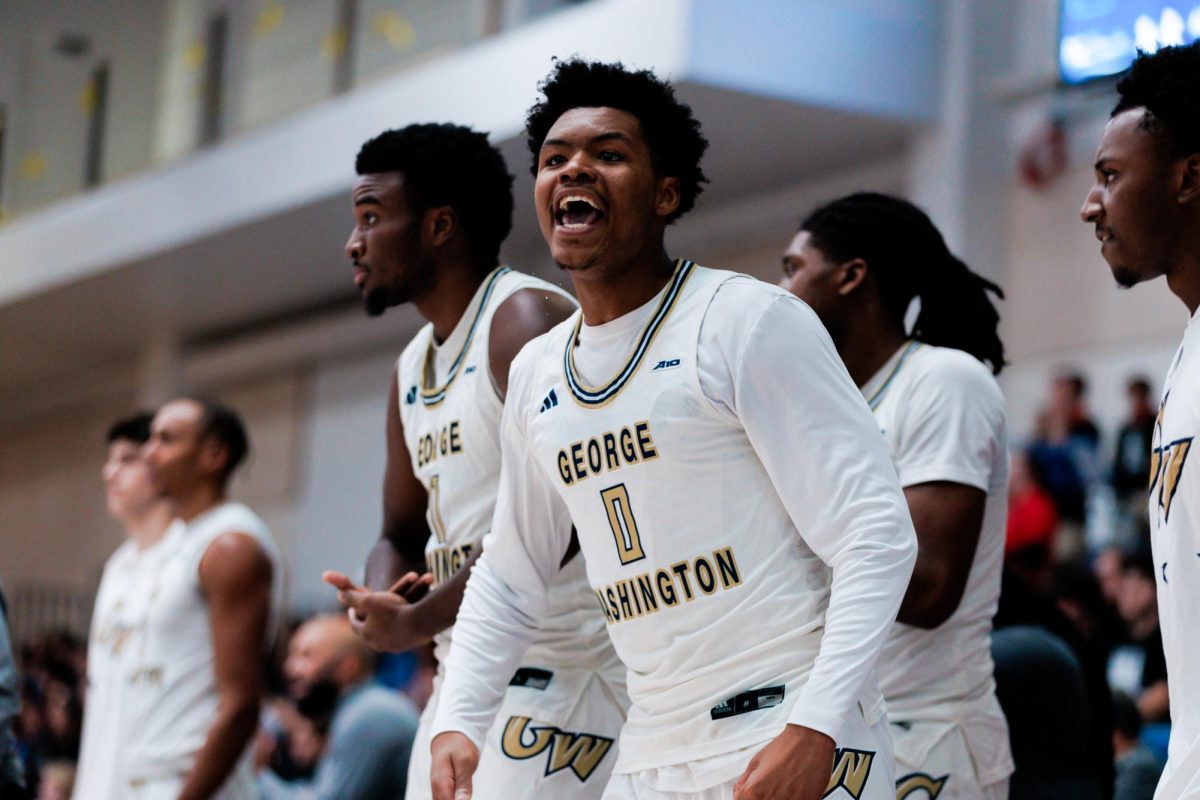Game day at Barcroft Park begins shortly after 9 a.m. for the GW baseball team, when three dozen players and coaches file out of a trio of vans to start their Saturday. Daniel Rollins, a volunteer assistant coach, is already there, holding a hose and spraying down the infield dirt. He was there around the same time Friday and Thursday, the first two days in a three-game series with St. Bonaventure, but those games didn’t start till 3 p.m. Today they’ll play at noon, and after two days of field preparation, there’s not as much tidying up to do.
That’s part of the deal at Barcroft, the preparing and the tidying up. It’s a public park in Arlington, Va., just off Four Mile Run Drive and about three and a half miles from the nearest Metro stop. For nearly two decades, GW’s been playing here, the latest so-called home for a program that hasn’t truly had one.
The whole field is enclosed by a 10-foot chain-link fence, with blue mesh draped over the outfield wall. A brick apartment complex sits off its rightfield line and there is a parking lot on its left. There’s a drainage ditch near the wall in left-centerfield and patches of grass missing along the foul line. A small metal grandstand sits near each team’s covered bench, a short distance from first or third base, but the sightlines are angled and obstructed. When professional scouts come to evaluate talent, they squeeze into nooks between the press box and the dugout, or even into the dugouts themselves to get a good look.
“It’s hard to come to a field like this every day,” says junior Eric Cantrell, the team’s top starting pitcher. “But it’s what we have.”
When they exit the vans, the players swarm the field. They retrieve buckets and hoses and pipes, drag nets and construct screens, a colony of worker ants all focused on their routine. “Everybody has their own little job,” says senior Curtis Eward, and in a matter of minutes it’s all up and ready and time for the team to stretch.
“There’s a lot of coaching staffs and players in our conference and around the country – they don’t do any work,” says head coach Steve Mrowka. “They’re not swinging rakes, tamping the mounds. But we do it.”
***
The game itself takes no longer than an inning to take shape. In the top frame, Cantrell strikes out the first batter he faces on three pitches, induces the next one to fly out on four, and gets a soft line-out to second base to retire the side. In the bottom, the first four Colonials to come to the plate reach base safely – one of them on a dropped fly ball – and three of them score.
GW adds five more runs over the next three innings and a rout is born. Two of those runs come in the fourth inning: Brendon Kelliher begins making his way to first base after believing he watched ball four go by, then picks his bat back up with a smile and smashes the next pitch to deep left-centerfield.
“Oh, no you didn’t,” someone shouts from the dugout as the ball makes its way over the fence, and the Colonials lead by eight.
Their lead is threatened in the fifth when a pair of two-out errors gives the Bonnies four runs, all of them unearned in the scorebook.
“We’ve had a lot of lucky at-bats and lucked out,” Cantrell says after the game. “And that was their inning.”
Cantrell comes back out for a shutout sixth inning, then is relieved by freshman Brian Derner, who tosses two scoreless frames himself. The Colonials’ lead balloons again with seven runs in the bottom of the eighth, including a grand slam by sophomore Stephen Oswald in his lone at-bat of the game.
Sophomore Marshall Seedorff comes on to close things out in the ninth and the game ends on a double-play, the Colonials winning 15-4 to sweep St. Bonaventure and begin their Atlantic 10 slate with six wins in six games.
“We’ve just gotten good pitching, good defense, and we’re just scoring some runs,” Mrowka says simply. “We’re playing good baseball.”
“We seem to be hitting on all cylinders right now,” Cantrell says.
***
After a serpentine line of hand slaps and a post-game huddle, it’s time to get back to work. Buckets of baseballs are lugged out of the dugout, dirt is raked and mounds re-touched, and the remnants of one day of baseball at Barcroft are erased so that the next can begin anew.
Then the feast begins.
The grill has been going since the game’s early innings, smoke even pouring into left field at points, but only now can its food be eaten. The series-ending barbecue has been a tradition at GW baseball games for years, with the parents preparing burgers, hot dogs, sausages, and chicken for their sons after the last game in a series.
It’s currently organized by Tom and Kathy Gately, parents of junior pitcher Tommy, and residents of Reston, Va., who assumed supervising roles due to their proximity. Funding comes from a pool of parents who all chip in before the season.
“We could never believe that we had enough food,” Tom Gately says of their first days cooking. “And inevitably, it almost always gets eaten.”
So many of the games’ regular attendees are parents – some making the trip from as far as New Hampshire or California – because it’s not easy an easy trip to Barcroft for GW students, most of whom don’t have cars. There’s no transportation offered from campus and it’s not easy by bus, which requires a roundabout route, or Metro, with the nearest stop more than three and a half miles away. You can take a cab, but that’s expensive and doesn’t guarantee the driver will know where exactly you’re asking to go. Most students who come are those able to find a ride one way or another.
Players say they’d like more fans to be able to make it out, and maybe wish they played a bit closer to campus, but mostly they wish their field was better, wherever it may be.
When recruiting potential players, Mrowka says the coaching staff sometimes avoids showing them the field and must endure competing programs’ negative recruiting tactics. And when the Colonials travel to other schools, says Eward, “it’s like apples to oranges, man.”
Mrowka says there has been discussion with the University and Arlington County about a joint venture to renovate Barcroft Park and build a new structure on the site around the current field. Talks have been on and off for a little while, Mrowka says, with more scheduled in the coming months. But there has still been no tangible progress.
“We want to put in a legitimate stadium,” Mrowka says. “Make it top-notch, something to be proud of.”
For now, Barcroft Park will remain what it is.
“I think the athletic department has more stuff to worry about than getting us a new field,” Eward says. “As much as I would like to say that isn’t true, it is.”






